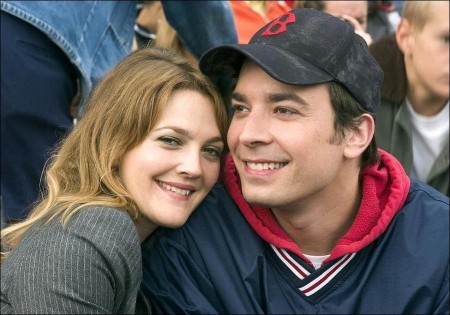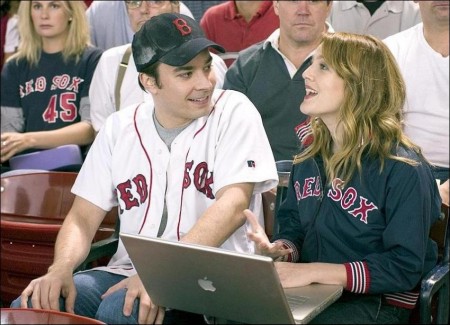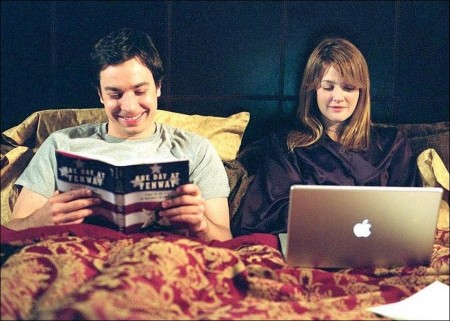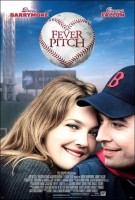Drew Barrymore and Jimmy Fallon star in Fever Pitch, a contemporary romantic comedy about a successful woman who thinks she’s finally met the perfect guy. Everything seems ideal until baseball season begins, and she has to compete with his first true love: the Boston Red Sox. It’s a love triangle – but with a twist. Instead of revolving around three people, story involves twenty-eight: a man, a woman…and a Major League baseball team.
High-school teacher Ben Wrightman (Jimmy Fallon) is a good catch. He’s charming, funny and great with kids. When he meets Lindsey Meeks (Drew Barrymore), an ambitious business consultant whose spirit is as luminous as her beauty, their attraction is immediate. Sure, they have their differences. She’s a workaholic; he loves his summers off. He lives and breathes the Red Sox; she doesn’t know Carl Yastrzemski from Johnny Damon.
But true love overcomes all… at least until Red Sox spring training rolls around. As Ben’s beloved Bosox launch one of the most incredible seasons in baseball history, Ben and Lindsey must decide if they, as a couple, will strike out or fight to keep love alive through extra innings.
FEVER PITCH is based on Nick Hornby’s autobiographical book Fever Pitch, which recounted the author’s obsession with English football (better known to Americans as soccer). But instead of “Americanizing” Hornby’s work, screenwriters Lowell Ganz & Babaloo Mandel took his premise of an obsessive sports fan, and fashioned a contemporary romantic comedy in the classic tradition.
The famed screenwriting duo, whose credits include “Parenthood,” “Splash,” “A League of their Own,” “City Slickers,” and Fox’s animated feature “Robots,” call the process of working on the FEVER PITCH script a true labor of love. “We really embraced the idea of making a classic-style romantic comedy,” says Ganz. “It was a real love affair for us to become immersed in the genre and write a script about which everyone would say, ‘Yeah, that’s the stuff. That’s how I remember romantic comedies.’ So writing FEVER PITCH meant a lot to us.”
“We found that romantic comedies aren’t really romantic comedies anymore,” adds Mandel. “We wanted to write a romantic comedy, with two people in love standing toe to toe.”
Ganz & Mandel’s script drew the attention of producers (and Flower Films partners) Drew Barrymore and Nancy Juvonen. “I just loved the script,” Juvonen recalls.
Then our head of development Gwenn Stroman, read it, and she really embraced it. So we gave it to Drew. Now Drew likes to read scripts on airplanes. On rare occasions – only when Drew really loves a script – she’ll call me from an airplane phone. The first thing she said was, ‘We have to make this movie!’”
“What drew me to FEVER PITCH,” says Barrymore, “is that it’s first and foremost a love story. You could remove the baseball component, and the questions it asks would remain the same: How much do you have to change to have a successful relationship? To what to degree do you accept a person for who they are and just work with it? I think those are themes that any couple can relate to”
Directors Peter and Bobby Farrelly also found themselves on the phone when they first got the script. “My brother read it first, and he called me,” Peter Farrelly remembers. “So I picked it up, started reading, and by the time I got to page 50, I started making phone calls of my own, saying ‘I’ve got to get in on this.’ The script was that good. I felt like we could have shot it the next day.”
At first – or second – thought the Farrellys wouldn’t seem the obvious choice to helm a romantic comedy. Working in the genre is a departure from their unique brand of envelope-pushing comedy, as vividly shown in films like “There’s Something About Mary,” “Me, Myself & Irene,” “Shallow Hal” and “Stuck on You.”
“Obviously, we have a history of making movies that are different from FEVER PITCH,” admits Peter Farrelly. “This is a good, old-fashioned love story. It doesn’t call for big, broad gags and outlandish humor. It’s a character-driven comedy, and it’s set in the real world. So we had to lobby hard to be considered. And, fortunately, Flower Films was able to let us onboard.
The script was in place, and the directors and the leading lady had been chosen. The only thing missing was a leading man. Barrymore wanted Jimmy Fallon for the role of Ben. “I had worked with Jimmy on ‘Saturday Night Live’ a few times, and I’ve always admired him as a comedian,” she says. “I thought FEVER PITCH would give him an opportunity to do something different.”
To prepare for the role, Fallon traveled to Boston’s historic Fenway Park, where he met fans every bit as obsessive as his character, Ben Wrightman. “I ran into these incredible fans before and after the Red Sox games,” says Fallon. “I got really caught up in their enthusiasm and the whole Fenway Park experience. It’s just an incredible place. And it’s a park. It’s not Fenway ‘Stadium.’ It’s intimate. I’ve heard players say they can actually feel the heat of the crowd when they’re down on the field. It’s amazing.”
“Jimmy brought a carefree, fun-loving feeling to the set,” Peter Farrelly says. “And so did Drew. They’re both extremely likable, as performers and as people.” Bobby Farrelly adds that Fallon had a youthful quality that suited his role. “Ben is a man, but he’s still a boy at heart,” says Farrelly. “It’s the boy in him that loves the baseball, who loves all these things that he can’t let go of.”
To depict Ben’s obsession with the game, Production Designer Maher Ahmad stuffed Ben’s with baseball memorabilia, including Red Sox sheets and towels. He replicated the Fenway Park’s famed outfield wall, the Green Monster, on one of Ben’s living room walls, while also adding accents familiar to Sox fans.
“We wanted to avoid overdoing it, making the things in the apartment look too geeky or pedestrian,” Ahmad explains. “Ben is an intelligent person. He’s a teacher and well educated, so I wanted to give the apartment a touch of sophistication, containing more than run-of-the-mill stadium souvenirs like foam fingers.”
Bobby Farrelly explains that it was critical that they get those kinds of little touches right. “Imagine a dyed-in-the-wool Sox fan who comes to see this movie and thinks, ‘Hmm. That’s not how I remember it…’ So even though this is a love story, we had to get the baseball details right. We have to be true to the people of Boston. And one thing I think my brother and I bring to this movie as directors is that we know this stuff. We’re from here [The Farrellys are native New Englanders]. We’ve lived with this team for as long as we can remember. We know every heartbreak and every player who has come down the pike.”
In fact, the Farrellys fulfilled a lifelong dream by shooting sequences at Fenway Park. (Toronto was another principal location.) The FEVER PITCH crew was given 10 days to shoot in Fenway; half of which were game days.
“We didn’t want to abuse the good will of the Red Sox organization and fans,” says Peter Farrelly. “Especially on game days. The fans are there to watch a ballgame. They don’t want their view of the field blocked by a bunch of guys trying to make a movie.”
Perhaps the most anxious moment for the filmmakers came at the end of one game, when the Farrellys had to walk out onto the field and ask 37,000 fans to remain in their seats while the production filmed a scene that had Drew Barrymore running across the field. Fortunately, Bobby Farrelly immediately won over the fans with a goodnatured jibe about the Bosox’s opponents, the New York Yankees.
“I don’t know if anything will ever compare to the experience of filming at Fenway,” says Bobby Farrelly. “To be there capturing it all on film was magic.”
Just when it seemed like the magic had reached its crescendo, the unthinkable – what Barrymore calls “the miracle, the absolute phenomenon” — occurred: The Red Sox started winning, making one of the most incredible comebacks in baseball history. In 2004, the Red Sox won the World Series, finally ending the “Curse of the Bambino.” The Red Sox won fifth World Series in 1918, but then suffered an 86-year losing streak after trading Babe Ruth (“The Bambino”) to the Yankess.
During production, the Farrellys set up two monitors while they worked, one that showed the scene they were filming, the other that televised the games. Red Sox Fever, already a contagious force on the set, became an epidemic. “I got incredibly superstitious,” Barrymore says. “I didn’t want to talk about it with anyone.”
And suddenly, the original script that everyone loved so much, the one that no one had wanted to change, had to go into rewrites. The Red Sox, the world’s perennial underdogs, were going to the World Series.
“It was a lot of work for Lowell Ganz & Babaloo Mandell, ” Peter Farrelly says. “They had to keep updating all the time. Luckily, though, only the last 10 percent of the movie was affected.”
“Our script had the Red Sox dropping out of the pennant race,” recalls Lowell Ganz. “Of course, with their phenomenal streak, that had to change. We re-timed things, so the story would take place during the pennant series, when the Red Sox were down three games to nothing. But it’s still the same movie.”
When the Red Sox traveled to St. Louis for the World Series, the Farrellys were reluctant to join them, for fear of jinxing the team. Bobby Farrelly admits: “I have to give credit to my brother, because he said, after they were up three to nothing and they were about to play Game Four, ‘Why aren’t we there? If they win this, we’ve got to be there.’ And somehow we pulled it together. We flew to St. Louis, without cameras or any equipment.”
“I got a message saying ‘Pack your bags. We’re leaving in three hours,’” Jimmy Fallon recalls. “There were no hair or makeup people. We even wore our scene clothes on the plane.”
“Of course, the Sox did win the game,” Bobby Farrelly says. “Major League Baseball let us out on the field, and we got footage that would have been impossible to recreate.”
“We always said from the beginning that whatever happened to the Red Sox wouldn’t affect the story,” Peter Farrelly notes. “FEVER PITCH doesn’t rest on whether the Red Sox win or lose. But hopefully capturing their win the way we did makes the movie that much richer.”
Shooting this final scene, as well as the entire FEVER PITCH experience, left an indelible impression on Drew Barrymore. “Think about it: we got to shoot the end of our film at the World Series, with a team that hasn’t won the Series for 86 years and has had this legendary curse on them. And we were right there, filming them win at the same time we shot the culmination of the film’s love story.
“I was such a newcomer to the temple of baseball when I came onto this film,” Barrymore continues. “This was partly intentional, because my character doesn’t know about it, either. But the more I’ve learned about baseball, and especially the story of the Red Sox, which is romantic, heart-wrenching and full of superstition, the more I see that the Red Sox’s journey is wonderful parallel to the love story we’re telling. FEVER PITCH asks, if you struggle to believe in something, can you really make it happen? And I think the answer is, yes.”
These production notes provided by 20th Century Fox.
Fever Pitch
Starring: Drew Barrymore, Jimmy Fallon, Lenny Clarke, Jack Kehler, Marisa Jaret Winokur, KaDee Strickland
Directed by: Bobby Farrelly, Peter Farrelly
Screenplay by: Lowell Ganz & Babaloo Mandel
Release Date: April 8th, 2005
Running Time: 101 minutes
MPAA Rating: PG-13 (for crude and sexual humor and some sensuality)
Studio: 20th Century Fox
Box Office Totals
Domestic: $42,071,069 (83.4%)
Foreign: $8,380,238 (16.6%)
Total: $50,451,307 (Worldwide)




